Today, I am sharing my recipe for an easy-to-make Pea Salad as another way to enjoy those lovely garden-fresh peas.

Today, I am sharing my recipe for an easy-to-make Pea Salad as another way to enjoy those lovely garden-fresh peas.


A vinaigrette is simply a dressing for salads and, at its most basic, is made by mixing oil and vinegar together and perhaps adding a sprinkle of salt. However, to add more flavor, vinaigrettes are often enhanced by the addition of herbs (fresh or dried), spices, salt, mustard to emulsify the oil and vinegar, a sweetening agent such as honey, maple syrup, or sugar, and sometimes fresh product like shallots, garlic, and/or citrus zest/juice.
While it may seem easy to simply pick up a bottle of salad dressing at the supermarket, there are so many reasons to whip up a simple vinaigrette at home.
There are all kinds of opinions on the “best” oil to use in vinaigrettes. Essentially, any edible oil (a key ingredient) can be used as the foundational base for a basic vinaigrette. This would include neutral-flavored vegetable oils, such as canola, sunflower, etc. However, my preference is to use a high-quality extra virgin olive oil because I find, with its fruity notes, it gives the best flavor and taste on my palate without introducing any strong intrusive flavor.
Specialty olive oil stores will carry a wide variety of oils that range from very mild to quite robust, as well as ones that are flavor-infused. I don’t tend to use flavored oils in my vinaigrettes as I bring the flavor out with the choice of vinegar and seasonings instead. Because you are going to be tasting the olive oil directly in the salad dressing, I recommend using top-shelf quality oil, not the standard low-grade oils often found on sale in supermarkets. It does make a difference to the flavor of the salads for sure. Here, in my home town, we have a specialty shop that sells high grade olive oils and balsamic vinegars and that’s where I buy my two core vinaigrette ingredients. I am a big fan of salads and I don’t skimp on the quality of ingredients for my vinaigrettes which can make or break a salad.
The second core ingredient in a vinaigrette is the acidic component – i.e., the vinegar. Since the vinegar is going to be a key ingredient for giving flavor to the vinaigrette, I recommend, as with the olive oil, using top-shelf quality vinegars. Trust me, there is a discernible difference between different grades of vinegars.
There are several different types of vinegars that can be used to make vinaigrettes and, indeed, certain types of salads, because of their ingredient composition, demand different vinegars. Common vinegars used in vinaigrettes include champagne vinegar, white wine vinegar, apple cider vinegar, red wine vinegar, and my personal favorite and “go-to” vinegar for most vinaigrettes – balsamic vinegar (either light or dark and either plain or flavor-infused).
As mentioned above, we are fortunate here in PEI to have a specialty store that sells quality olive oils and balsamic vinegars and I maintain a variety of their products in my kitchen so my vinaigrettes vary in flavor. Most specialty stores selling these products will allow you to taste-test them before purchasing which is a real benefit.

So, let’s take a brief look at some of the most common types of vinegars typically used to make vinaigrettes:
Champagne Vinegar – This is a very light and mild, delicate vinegar and is great to use in vinaigrettes for fruit-based salads and those with delicate greens such as the mesclun mix (aka spring greens). This is a vinegar I often use in my homemade Chive Vinegar.
White Wine Vinegar – This vinegar is a mellow vinegar, stronger than Champagne Vinegar, but also good in vinaigrettes destined for dressing delicate salad mixes with tender leafy greens. Can also be used for making Chive Vinegar.
Apple Cider Vinegar – This vinegar has a fruity, somewhat sweet, flavor and is not overly strong and tangy. It is a good choice for vinaigrettes, especially in autumn or winter, to dress salads containing apples, squash, cranberries, meat, nuts, cheese, etc. Good also on pasta salads.
Red Wine Vinegar – This is a robust tangy vinegar with a strong flavor profile. Considered a bold-flavored vinegar, this vinegar is often used in vinaigrettes for Greek and Italian salads containing a variety of bold flavored ingredients like peppers, tomatoes, olives, etc. Often used in vinaigrettes for dressing for pasta salads, too.
Balsamic Vinegars – These aged vinegars have complex flavorful profiles and, with the blend of sweet and sour notes, complement a wide variety of salads. Balsamics are available in light and dark varieties and in a seemingly endless array of flavors beyond the basic versions.
Note that the suggestions above for vinegars and for their uses in terms of vinaigrettes are just that – suggestions/guidelines – they are not carved in stone. Use your personal taste preferences to decide which vinegar makes the most pleasant vinaigrette for you.
There are five basic ingredients in a standard vinaigrette:
Beyond these core ingredients, additional optional seasonings can be added – e.g., herbs (fresh or dried), spices, shallots, garlic (either garlic salt/powder or fresh finely minced garlic), finely grated citrus zest, citrus juice, freshly ground pepper, and so forth. When adding any optional add-ins, consider the salad ingredients and choose add-ins that complement the salad composition.
If adding fresh herbs, I recommend adding them only at time of serving or shortly before as, otherwise, they will quickly appear very wilted and unappetizing if added too early to the vinaigrette. If you plan to store the vinaigrette over several days or weeks in the refrigerator for later use, I don’t recommend adding any fresh product (e.g., shallots, garlic, citrus zest, etc.) until time of serving, or near to it.
For the most part, but not exclusively, I follow the traditional French vinaigrette ratio for core ingredients of 3:1 – that is, 3 tablespoons of oil for every tablespoon of vinegar (regardless the kind of vinegar used). This ratio can be expected to yield a vinaigrette that is both flavorful and somewhat tangy. While, over time, the 3:1 ratio has become somewhat of a holy grail for vinaigrette making, there is some room for flexibility. For example, some use a 4:1 ratio which will yield a slightly thicker and more creamy vinaigrette. Additionally, the ingredients in a vinaigrette are also somewhat flexible and can be adjusted according to personal taste. I suggest, if you are new to vinaigrette making, start with the basic 3:1 ratio for vinaigrettes, and then, if you deem it necessary, make any adjustments needed to please your taste. You’ll soon get to know if the standard ratio of ingredients suits your taste or if you need to add a bit more vinegar, oil, or sweetener.
There are some hints and tips to help you make adjustments, if and when needed, to vinaigrettes. For example,
I would caution, however, that these alterations/adjustments should be made in small increments and be sure to taste the vinaigrette as you go.

There are various methods for making a vinaigrette:
The vinaigrette can be made and instantly used to dress the salad or it can be made a few hours ahead of time to allow the flavors to mix and mingle. If you are planning to keep the vinaigrette over, store it in a tightly covered jar in the refrigerator. So long as there are no fresh products in it (e.g., no fresh herbs, minced garlic or shallots, grated citrus zest, etc.), it will keep two weeks or so in the refrigerator. If the vinaigrette contains fresh product, store it in the refrigerator for no more than 2-3 days.
Remove the vinaigrette from the refrigerator 20-30 minutes before serving time to allow the solidified ingredients to liquify then give the jar a good vigorous shake or use a whisk to remix the ingredients thoroughly.

It actually takes very little vinaigrette to dress a salad, a lot less than you might think. A little goes a long way. You don’t want to soak or saturate the salad ingredients with the vinaigrette. Basically, just use enough that the lettuce and veggies/fruit are very lightly coated and moistened. Dress the salad with very small increments of the vinaigrette at a time and toss the salad ingredients as you go, continuing to add small amounts of the vinaigrette, if and as needed, until ingredients are lightly coated. Essentially, it comes down to the size of salad you are making and personal preference as to how much vinaigrette is needed to dress a salad. However, if, after eating the salad, you see a pool of vinaigrette in the bottom of the bowl or on the plate, that is an indicator that too much vinaigrette was used and the amount needs to be reduced in future.
So, even though the good quality olive oil and vinegar are expensive, they go a long way when used in vinaigrettes, making it an economical (and I’d argue, healthier) alternative to bottled salad dressings bought at the supermarket.
Once you start making your own vinaigrettes at home, and experience how clean they taste and how they brighten and make salads come alive and allow you to taste and enjoy the flavor of each individual ingredient in the salad, you’ll wonder why you haven’t been making vinaigrettes right along!

If you are new to making vinaigrettes, I recommend starting with my small batch vinaigrette recipe below which will yield approximately ¼+ cup, enough to dress about 4+ salad servings (depending, of course, on the size and composition of the salad(s) as well as personal preference). You don’t want to waste expensive ingredients mixing up a large amount of vinaigrette only to discover it doesn’t match your taste preferences. Once you find a vinaigrette mix you like, it can easily be doubled (as shown in the photo above), tripled, and so forth to make a bigger batch at a time.
Once you have the basic formula of oil to vinegar, the composition of the vinaigrette is very flexible. Try different kinds of vinegars and oils and different combinations of each. Use lemon juice instead of vinegar or try making a vinaigrette using half vinegar and half lemon juice. Add different seasonings and optional add-ins and you will have a constant variety of creative and flavorful vinaigrettes.
While vinaigrettes are most commonly used to lightly dress salads, they can be used as:

Ingredients:
1 tbsp high-quality balsamic vinegar
½ – ¾ tsp Dijon mustard
¾ – 1 tsp maple syrup or honey, or to taste
fine sea salt, to taste
3 tbsp high-quality extra-virgin olive oil
Optional Add-in Examples (add as few or as many as you like to complement the salad ingredients for which the vinaigrette will be used):
Apx. ½ tsp dried herbs of choice or 1½ – 2 tsp fresh herbs, finely chopped (e.g., dill, parsley, oregano, etc.)
Apx. 1 tsp finely minced shallots
1/16 tsp garlic salt or powder (or 1 small garlic clove, finely minced), or to taste
¼ – ½ tsp finely grated citrus zest
¼ – ½ tsp citrus juice
fresh ground pepper, to taste
Method:
Whisk the vinegar, mustard, maple syrup or honey, and salt together in small bowl (if using any add-ins, combine them, too). Whisk in a few drops of the olive oil then continue adding the olive oil, in a slow, steady stream or dribble, until very well combined with ingredients. Alternatively, add all ingredients in a tightly capped jar and shake it vigorously until all ingredients are thoroughly blended.
Dress the salad with the vinaigrette, a small amount at a time, tossing the salad ingredients to moisten and lightly coat them.
So long as no fresh products (e.g., herbs, shallots, garlic, citrus zest, etc.) have been added to the vinaigrette, any leftover vinaigrette can be stored in a tightly covered jar in the refrigerator for up to two weeks. Remove vinaigrette from refrigerator 20-30 minutes before serving time to allow solidified ingredients to liquify and then whisk the vinaigrette to remix ingredients thoroughly before dressing salad.
Yield: Apx. ¼+ cup
NOTE 1: This recipe is scalable, meaning it can, using the basic 3:1 formula for amounts of oil to vinegar, be multiplied as many times as necessary to make as much vinaigrette as is needed.
NOTE 2: While the recipe calls for Balsamic Vinegar and Extra-Virgin Olive Oil, any vinegar and oil of choice can be substituted, using the same 3:1 formula.
Join the Facebook page for My Island Bistro Kitchen: https://www.facebook.com/MyIslandBistroKitchen/
Follow “the Bistro” on “X” (formerly Twitter): https://twitter.com/PEIBistro/
See the drool-worthy gallery of mouth-watering food photos from My Island Bistro Kitchen on Instagram: https://www.instagram.com/peibistro/
Follow “the Bistro” on Pinterest at https://www.pinterest.ca/peibistro/ and pin one of the Pinterest-ready photos at the end of this posting to your favorite Pinterest boards!

Yield: Apx. ¼+ cup
NOTE 1: This recipe is scalable, meaning it can, using the basic 3:1 formula for amounts of oil to vinegar, be multiplied as many times as necessary to make as much vinaigrette as is needed.
NOTE 2: While the recipe calls for Balsamic Vinegar and Extra-Virgin Olive Oil, any vinegar and oil of choice can be substituted, using the same 3:1 formula.
[Copyright My Island Bistro Kitchen]

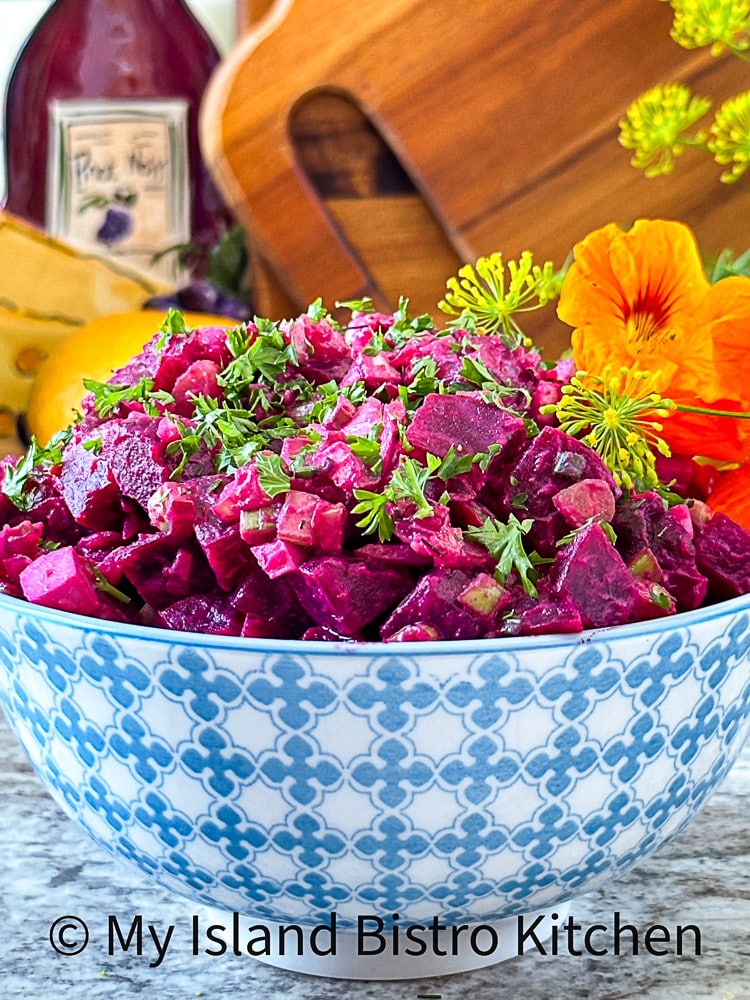
This easy-to-make Beet Salad is a great side salad to any meal. Made with simple ingredients and lightly dressed with a vinaigrette, the salad is a tasty welcome on the table. Continue reading The Bistro’s Beet Salad Recipe
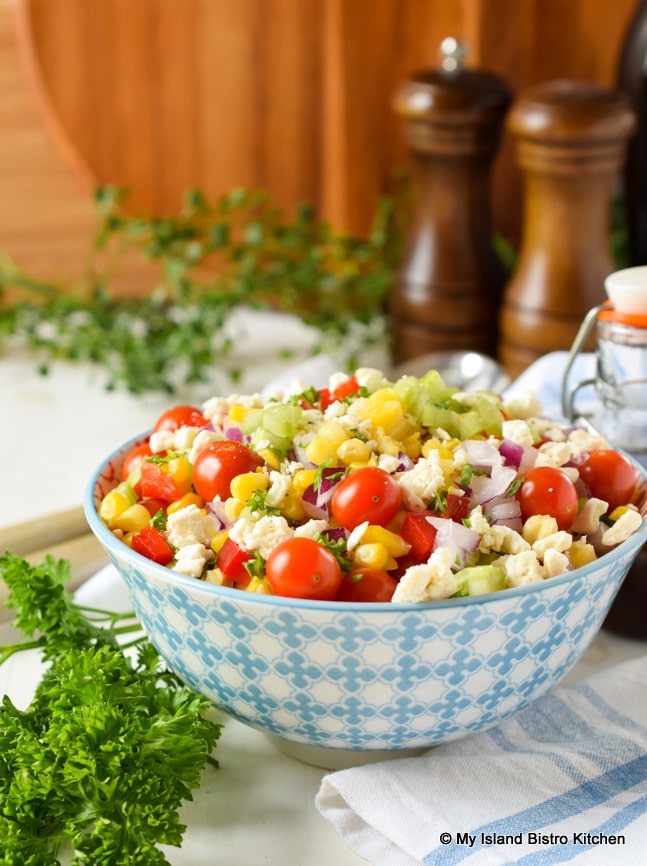
If you are a salad lover like me, sometimes you just need to see a different salad on the table to the traditional green salad. Try this lovely Fresh Corn Salad when the local corn is in season. Continue reading Fresh Corn Salad Recipe
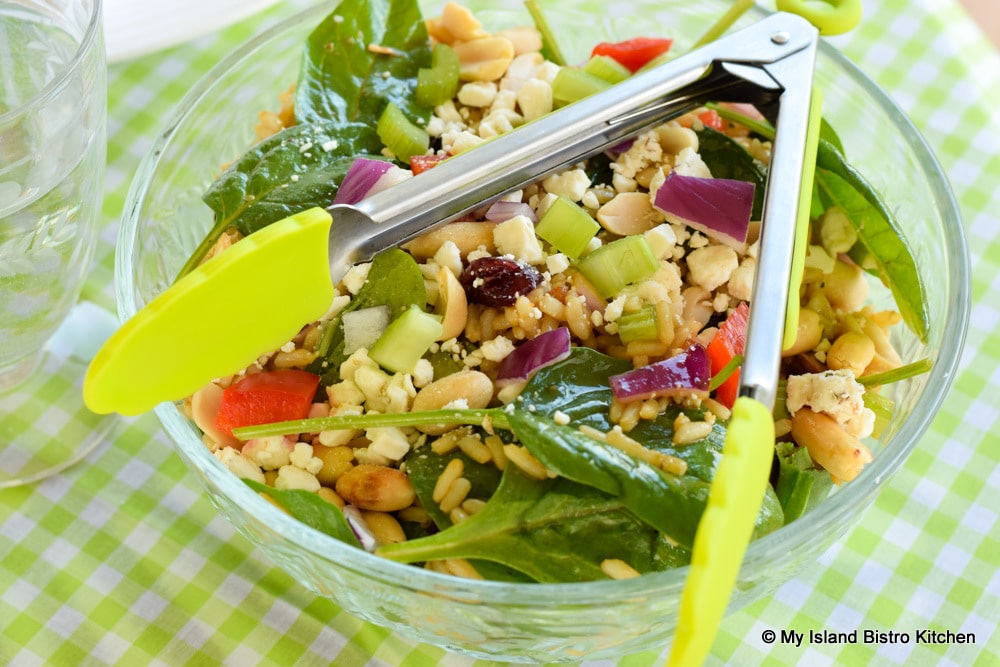
I call this my “old faithful salad”. It’s so tasty, it’s almost addictive! This Rice and Spinach Salad is a hearty salad filled with cold cooked long grain rice, bright green healthy fresh spinach, veggies, dried fruits and nuts, and tangy crumbled Feta. A light vinaigrette dressing is all that is needed to complete this tasty salad. Continue reading Rice and Spinach Salad Recipe
When you need a bright, colorful, tasty, and refreshing summertime salad, this Watermelon, Cucumber, and Red Onion Salad with Feta, dressed with a light vinaigrette, checks all the boxes. Continue reading Watermelon, Cucumber, and Red Onion Salad with Feta
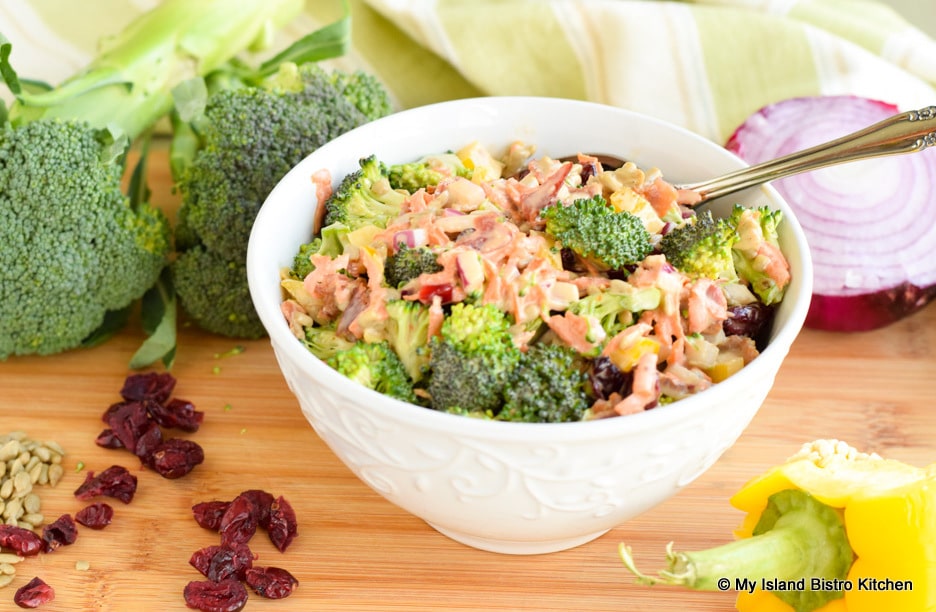
This classic Broccoli Salad is wonderfully tasty and can be served with a number of different meals. It is great for potlucks, cookouts, and picnics (provided, of course, it is kept cold due to the mayo and sour cream content). Continue reading Classic Broccoli Salad Recipe
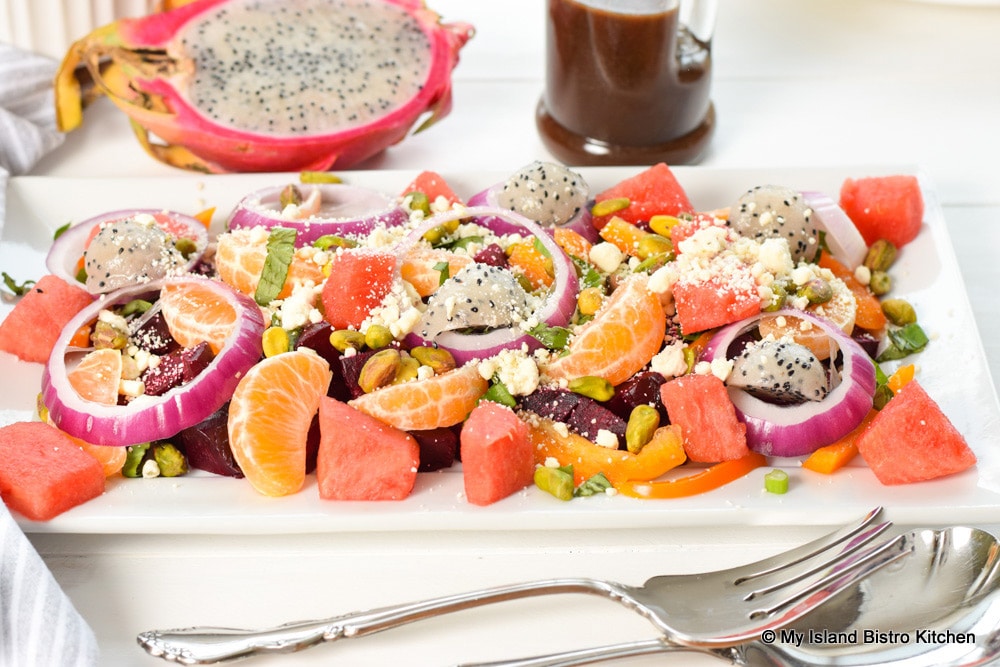
Today’s Beet, Watermelon, and Dragon Fruit Salad is an eye-catching bright mix of fruits and vegetables that combine to make a refreshing salad drizzled with a light and flavorful vinaigrette. Continue reading Beet Watermelon and Dragon Fruit Salad

Salads are a big part of our diet, especially in the summer and early fall when we eat from our garden and, this year, my go-to recipe has been this delicious Mango Salad Dressing which, I must admit, I eat like candy! It is lusciously smooth, bright colored, and has a lovely flavor that complements many different kinds of salads. Continue reading Mango Salad Dressing Recipe

We grow a garden and live out of it in the summer. Lots of different varieties of lettuce are grown and so salads are an almost daily part of our menu. On hot summer days, I love to make what I call a main meal salad like this Chicken and Quinoa Salad with Star Anise and Orange Vinaigrette. Continue reading Chicken and Quinoa Salad with Star Anise and Orange Vinaigrette
Homemade salad dressing is simple to make and is a tasty addition to many salads and sandwiches. It’s also a more economical alternative to commercial varieties on the grocery store shelves. Additionally, if you find yourself in need of salad dressing and are not near a supermarket, you can quickly whip up a batch of homemade salad dressing so long as you have eggs, sugar, milk, vinegar, dry mustard, and flour. Continue reading Homemade Salad Dressing
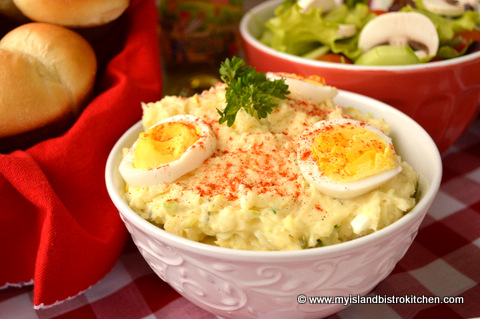
One of the most popular salads in PEI in summer is the traditional potato salad. There are several variations to this salad and, of course, the jury is still out on whether the potatoes should be diced or mashed! While the quantities of ingredients may vary somewhat and certain different seasonings may be added to potato salad, the same basic essential ingredients in most salads will be potato, egg, celery, onion, salad dressing, salt and pepper. So long as you have these common ingredients, you can make a basic potato salad. Of course, I think PEI potatoes make the best salad (but, then again, I may be just a wee bit biased on that front)!
I like to use a combination of homemade and bought salad dressing as I find the flavors play well off each other – I use about 50/50 of each. However, I have made the salad with just one type of salad dressing and it turned out fine. I also like to add a bit of sour cream, sweet pickle relish, and prepared mustard. The latter two ingredients give a bit of ‘punch’ to the salad. The key, of course, is not to over-do the addition of any seasonings because the potatoes need to ‘star’ and we don’t want to do anything to detract from their flavor. In summer when I have fresh herbs in the garden, I like to add just a tiny bit of chopped fresh dill and some parsley.
The traditional style of potato salad is to cube/dice the potato and egg as shown in the photo below.
However, my preference is to mash the potato and egg, particularly if I am looking for good plating presentation. This is because the mashed potato salad fits well into the bowl of an ice cream scoop and, therefore, looks lovely on a plate. However, if you are looking for a more rustic style potato salad, then the cubed/diced potato style is the way to go. This is purely a personal preference because, let’s face it, if you use the same ingredients, it will all taste the same! All that will be different will be the texture and appearance.
As to how much salad dressing to use, this will depend on several factors so the amount I have given in my recipe below is a guide. For example, the quality of the potatoes (how dry or moist they are), the thickness of the salad dressing, and/or the consistency of the sour cream can all influence how much salad dressing is needed. As well, you may find that cubing/dicing the potatoes may take a different amount of salad dressing than do mashed potatoes. Lastly, it is personal preference as to how moist the salad should be. It should not be ‘soupy’ but there should be enough salad dressing to hold/bind the salad together. I tend to like my potato salad quite moist. I recommend starting with a good one-half of the salad dressing called for in the recipe and then adding more to reach the consistency you desire.
Plan to make the potato salad several hours ahead of when it is needed. Refrigerate it for at least three hours or more to allow the flavours to blend.
Potato salad is very versatile. It often is served as a traditional side dish for picnics and barbeques. It goes great with cold cuts, lobster, grilled pork chops, barbequed chicken, sandwiches of all kinds, and the list goes on. In my household, potato salad always has to accompany a feed of PEI lobster!

The recipe below is my own personal potato salad recipe. I hope you enjoy it.
Ingredients:
1½ lbs PEI potatoes
2 hard boiled eggs
¼ cup celery, finely chopped
2½ tbsp onion, finely chopped
⅔ cup salad dressing (apx.)
2 tbsp sour cream
3 tsp. sweet relish
2 tsp. prepared mustard
¼ tsp sugar
Salt and pepper, to taste
¼ tsp fresh dill, chopped (optional)
1½ tsp fresh parsley, chopped (optional)
Method:
Cook potatoes, skins on, in pot of boiling water just until potatoes are fork tender. Drain. Let potatoes cool enough to handle. Peel. Cube or mash potatoes, as desired, into medium-sized bowl.
Mash or dice eggs. Add to potato.
Add the celery, onion, mustard, sweet relish, sour cream, salad dressing, and sugar.
Note – Add about ½ the salad dressing to start, then continue to add enough salad dressing to reach desired consistency. Mix well. Season with salt and pepper.
Add fresh dill and parsley, if desired.
Cover and refrigerate for at least 3 hours to allow flavors to blend. Serve salad on a bed of lettuce. Refrigerate unused salad immediately.
Yield: 5-6 servings (2 scoops salad per serving)
Join the Facebook page for My Island Bistro Kitchen: https://www.facebook.com/MyIslandBistroKitchen/
Follow “the Bistro” on “X” (formerly Twitter): https://twitter.com/PEIBistro/
See the drool-worthy gallery of mouth-watering food photos from My Island Bistro Kitchen on Instagram: https://www.instagram.com/peibistro/
Follow “the Bistro” on Pinterest at https://www.pinterest.ca/peibistro/ and pin the Pinterest-ready photo found at the end of this post to your favorite Pinterest boards.
A moist and tasty potato salad that is the perfect accompaniment to any lobster feed, barbeque, or picnic
Ingredients
Instructions
![]()
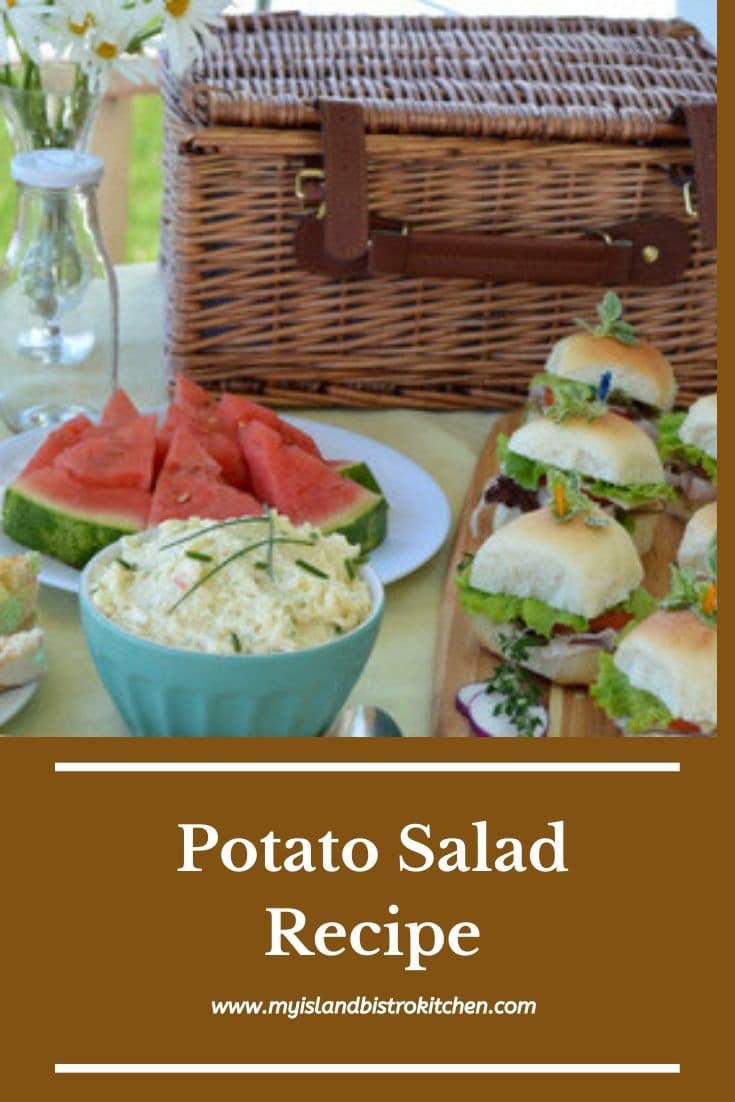
National Tartan Day is celebrated each year on April 6th which coincides with the signing of the Scottish Declaration of Independence — the Declaration of Arbroath — in 1320. It is a day of observance to recognize and celebrate the Scottish heritage and the contributions of the Scots and their descendents to Canada’s history, development, and culture. You can read more about Tartan Day and its origins here.
I wondered what the focus of my posting would be for this year’s Tartan Day. Lo and behold, didn’t I find bow tie pasta in shades of the Prince Edward Island tartan – red, green, and ivory! Mind you, the colors are not an exact or perfect match but I think they are close enough to work in a colorful pasta salad with herb dressing. Continue reading Pasta Salad in Shades of the PEI Tartan
I love late August because there is an abundance of fresh garden produce available. Vegetable and dip platters make a great snack for any occasion. Vegetables are so colorful that they make any platter look outstanding plus raw vegetables are healthy food. Today, I am sharing my recipe for a Summer Garden Vegetable Dip. Continue reading Summer Garden Vegetable Dip
Summertime means lots of fresh salads. I like to make my own vinaigrettes, like this Rhubarb Vinaigrette, because they are not full of preservatives and they are easy to make. Continue reading Rhubarb Vinaigrette
We have eaten a lot of salads from our garden produce this summer and I must admit I am starting to get a bit tired of the traditional green salad with tomatoes, cucumber, etc. The peaches have been divine this late summer so, for a change, I decided to grill them and make a fruit salad on fresh garden greens.
This is a tasty salad with the grilled peaches, fresh blueberries, red onion rings, and feta cheese on a bed of mixed greens. I topped it off with a peach balsamic vinaigrette made with peach balsamic vinegar and mandarin-infused olive oil from the Liquid Gold store here in Charlottetown.
To grill the peaches, I cut each in half, removed the stone, and brushed both sides of the peaches with the mandarin- infused olive oil. Make sure the grill is greased as well.
On a pre-heated grill (medium-high), the peaches only take 2-3 minutes, each side (use tongs to turn the fruit). Don’t overcook the fruit as it will become too soft and mushy. Grilling fresh fruit brings out the deep flavor of the fruit and intensifies the sweet taste. Plus, the grill marks on the peaches, enhance the presentation.
For salad for two:
mixed greens
2 grilled peaches
blueberries
red onion rings
feta cheese
To make the dressing:
1/4 cup mandarin-infused olive oil
2 tbsp peach balsamic vinegar
4 tsp Dijon mustard
1 tsp minced garlic
1 green onion, finely sliced
2 tsp fresh lemon juice
2 tsp sugar
pepper, to taste
Kosher salt, to taste
Mix all ingredients together. Shake well. Drizzle over salad when ready to serve.
To assemble salad:
Make a bed of mixed greens on each plate. Place sliced grilled peaches on greens. Add red onion rings. Sprinkle with blueberries and feta cheese. Drizzle with Peach Balsamic Vinaigrette.
Thank you for visiting “the Bistro” today.
Be sure to visit my new Facebook page at My Island Bistro Kitchen. You may also wish to follow me on twitter @PEIBistro and on Pinterest at “Island Bistro Kitchen”.
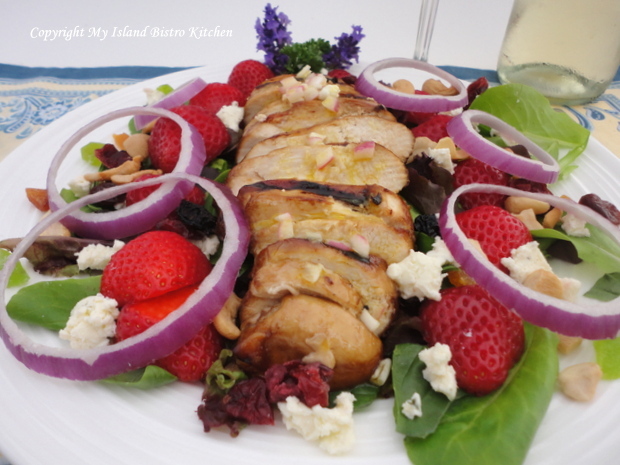
With warm summer evenings, it’s nice to have a go-to recipe for an easy-to-prepare, light yet filling, entrée. One of my favorite summertime evening meals is warm grilled chicken served over a strawberry, feta cheese, and green salad and drizzled with a good balsamic vinaigrette.
The option is yours to choose to marinade the boneless, skinless chicken breasts or not. I usually do and I don’t follow a precise recipe for the marinade but these are the usual ingredients: brown sugar, olive oil, balsamic vinegar, garlic, minced onion, soya sauce, salt, and pepper. As for quantities of each ingredient, I don’t actually measure them out and add more or less, depending on how many chicken breasts I am marinating. I make several horizontal cuts in the chicken breasts to allow the marinade to permeate through the meat. Place the chicken breasts in a ziplok bag, mix together the marinade and pour it into the bag, making sure the entire chicken breasts are covered. Zip up the bag and place it in the fridge for several hours (I usually aim for between 2 and 4 hours). Heat up the grill and cook the chicken breasts until they are done.
One of the pleasures of summer is having our own garden. We eat a lot of salads and there is nothing better than running to the garden right before meal time and gathering a medley of fresh lettuce as well as some herbs from our little herb garden.
Slice the warm grilled chicken breast horizontally into slices about ¼” thick.
Cover the plate with a medley of greens. Transfer the cut-up chicken breast to centre of the plate on top of the lettuce bed. Slice up and add some fresh strawberries and red onion rings. Sprinkle with feta cheese and a few nuts such as cashews or sunflower seeds (or both!). Add a balsamic vinaigrette and voila, a tasty and light dinner. Serve with baguette slices and a refreshing glass of your favorite white wine. Here I have selected “flipflop”, a California Pinot Grigio which made a fine accompaniment to a summer salad.
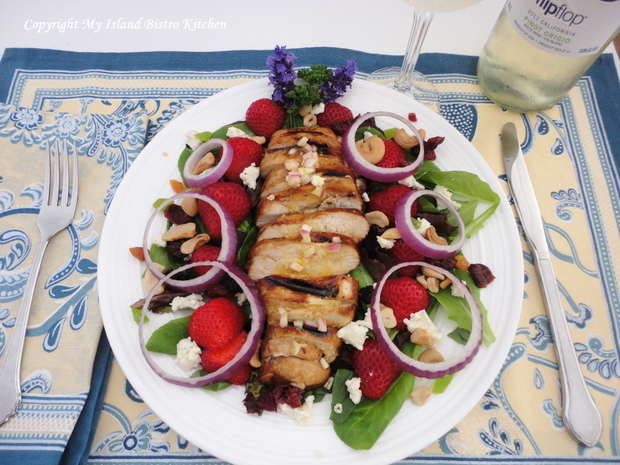
My recipe for the vinaigrette follows. Of course, you know the secret to a really good vinaigrette – the best quality of olive oil and balsamic vinegar you can find. Because we have a “Liquid Gold Tasting Bar & All Things Olive” store in Charlottetown, I buy their olive oil and vinegar products because they are superior and fresh quality.
Peach and Mandarin Balsamic Vinaigrette
¼ cup Mandarin-infused olive oil
2 tbsp peach white balsamic vinegar
4 tsp Dijon mustard
1 tsp minced garlic
1 small green onion or 1 – 2 tsp finely chopped red onion
2 tsp freshly-squeezed lemon juice
1 ½ – 2 tsp sugar, to taste
Freshly ground pepper
Kosher salt, to taste
Mix and shake all ingredients together until well mixed. Drizzle over salad at time of serving.
Thank you for visiting “the Bistro” today. There are lots of ways to connect with “the Bistro” through social media:
Join My Island Bistro Kitchen on Facebook
Follow the Bistro’s tweets on twitter @PEIBistro
Find the Bistro on Pinterest at “Island Bistro Kitchen”
Follow along on Instagram at “peibistro”